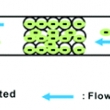댓글 쓰기 권한이 없습니다. 로그인 하시겠습니까?
Effect of surface ligand density on near-infrared electrochemiluminescence of glutathione-stabilized Au nanoclusters
| Journal | Electrochimica Acta |
|---|---|
| Author | Jeongyun Choi, Donghwa Kim, Joohoon Kim |
| Citation | Electrochimica Acta, 2024, 487, 144139. |
| DOI | https://doi.org/10.1016/j.electacta.2024.144139 |

Here, we report the crucial role of surface ligand density in electrochemiluminescence (ECL) of water-soluble Au NCs stabilized with glutathione ligands. The Au NCs, having four distinct surface ligand densities, displayed unique ECL features that were dependent on the surface ligand density of the NCs, similar to their fluorescence properties. The Au NCs displayed dual-wavelength ECL emissions at ∼620 nm and ∼820 nm. The ECL properties were significantly affected by the surface ligand density of the NCs, with lower densities resulting in enhanced ECL emission, particularly in the near-infrared region. This enhancement surpassed the near-infrared ECL emissions observed in other known ECL-active Au NCs, resulting in approximately a 9-fold improvement compared to well-established Au NCs stabilized with bovine serum albumin (BSA). In addition, the dual-emission features of the Au NCs stabilized with glutathione were attributed to the presence of two Au-S emission motifs related to different Au-S bonding environments resulting from varied surface ligand densities. These findings revealed the critical role of the surface ligand density in modulating not only the fluorescence of the Au NCs but also the ECL of NCs.?
-
Read More

Hybridization of DNA to bead-immobilized probes confined within a microfluidic channel
Category-2009 AuthorKim, J.; Heo, J.; Crooks, R. M. JournalLangmuir CitationLangmuir, 2006, 22, 10130-10134
-
Read More

Transfer of surface polymerase reaction products to a secondary platform with conservation of spatial registration
Category-2009 AuthorKim, J.; Crooks, R. M. JournalJ. Am. Chem. Soc. CitationJ. Am. Chem. Soc., 2006, 128, 12076-12077
-
Read More

Replication of DNA microarrays from zip code masters
Category-2009 AuthorLin, H.; Kim, J.; Sun, L.; Crooks, R. M. JournalJ. Am. Chem. Soc. CitationJ. Am. Chem. Soc., 2006, 128, 3268-3272
-
Read More

Parallel fabrication of RNA microarrays by mechanical transfer from a DNA master
Category-2009 AuthorKim, J.; Crooks, R. M. JournalAnal. Chem. CitationAnal. Chem., 2007, 79, 8994-8999
-
Read More

Replication of DNA microarrays prepared by in situ oligonucleotide polymerization and mechanical transfer.
Category-2009 AuthorKim, J.; Crooks, R. M. JournalAnal. Chem. CitationAnal. Chem., 2007, 79, 7267-7274
Designed by sketchbooks.co.kr / sketchbook5 board skin
Sketchbook5, 스케치북5
Sketchbook5, 스케치북5
Sketchbook5, 스케치북5
Sketchbook5, 스케치북5
.png)

